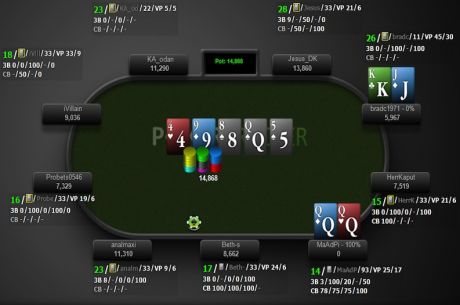Experimental Poker: Trying New Strategies in Low Buy-In Online Tourneys

After a dry spell in live tournaments left me reeling just a bit, I made a decision to try some low buy-in online tourneys as an inexpensive way to reconsider various aspects of my game.
Online tournaments can be a great way to fine tune your game, and even the low buy-in ones I chose to play can be challenging and provide lots of opportunities both to revisit fundamentals and even to try to incorporate new plays into your repertoire.
When reflecting on my recent live results, including a focused examination of my notes and hand histories, I discovered that I had fallen into playing too straightforwardly, essentially sticking with ��ABC Poker�� in most situations and thus becoming much too predictable to my opponents.
Of course, ��ABC Poker�� can be effective in many situations. Sometimes circumstances make it better to ��keep it simple�� than to try exotic plays �� something Robert Woolley was discussing earlier this week in his article ��Are Your Fancy Poker Moves Costing You Money?��
That said, experienced players enduring a downswing might find themselves instinctively reverting back to an ABC-style of play in the hopes of turning things around. Reviewing my own play, I found that was what had happened to me, and so when playing my low buy-in online tourneys I specifically focused on practicing some non-ABC plays in order to get out of the rut into which I had fallen.
Here are three ��non-standard�� plays on which I worked:
1. Floating the flop in position
Floating is a somewhat advanced play that involves calling a bet from position with a weak hand with a plan to bluff or outplay an opponent on a later street. To be perfectly frank, this was a play that had passed me by, so to speak. While I had likely always used a variation of the float in my own game, I never did so with intention and understanding of why I did so.
During this session of experimentation, I wanted to make a conscious effort to call bets on the flop while in position �� despite holding a hand that had missed everything �� with the objective of stealing the pot when my opponent slowed down. (For more on floating, see Josh Cahlik's discussion of ��Understanding Floating in Position.��)
2. The three-bet squeeze
One of the most powerful preflop plays in poker is the three-bet squeeze �� that is, reraising after a opening raise and call. As a tournament reporter I��ve seen countless pots that seemingly had potential for major action end with a whimper after the last player in the pot took it down with a three-bet without a contest.
I��ve always been intrigued by the moxie it takes to put in a big three-bet before the flop without a premium holding, but more and more I��m beginning to see that this can be a spot to try making a move. When playing from late position, I tried to identify prime opportunities to apply pressure with this power play, looking for instances in which an opening raise was flat-called by one or more players.
When the correct circumstances presented themselves �� i.e., when I was playing from either the button, the cutoff, or the hijack seat, with an opening raise and a call in front �� I decided to make a sizable three-bet every time and record the results.
3. Overbetting the river when I make a monster
Another aspect of professional tournament play which has always impressed me while reporting is the way great players extract maximum value from their monster hands.
Oftentimes during my recent rut, I found myself dragging disappointing pots my way after making the nuts, and it occurred to me that I simply wasn��t betting my made hands correctly. With extremely strong hands I found myself consistently betting small fractions of the pot �� say, a quarter-pot bet on the flop or a third-pot bet on the river. From my notes my reasoning appeared to be fear of ��scaring the sucker off.�� Instead, my opponents would willingly call my small bets with quality hands, showing how easily I could have earned more value by betting the pot or more.
For the sake of my experiment, I made a conscious effort to overbet the pot on the river when I held a presumed winner, tracking calls and folds to determine which route proved to be more profitable.
Results
Four hours after beginning my session of online tourneys, three multi-table buy-ins had materialized into one final table run, a fortuitous turn of events which allowed to me to keep practicing these same plays with a relatively deep stack. In the end, I found that each of the three plays discussed above were effective weapons to wield at the poker table.
When I floated flop bets in position, the result more often than not was the aggressor pumping the brakes, checking to me after firing one barrel. From there, all that stood between me and a decent pot was the willingness to fire my own barrel back my opponent��s way, and like clockwork opponents who had bet the flop and checked the turn folded their hands.
The three-bet squeeze play was a bit trickier to evaluate, because unlike floating a flop bet when the aggressor appears to hold air, a reraise and a call before the flop typically indicated my opponents had been dealt playable hands. When the right scenario unfolded, I made a total of 23 three-bet squeezes across my tournaments, with the result being 14 uncontested wins, 6 flat-calls and pots played on the flop, and 3 four-bets that forced me to fold.
All told, I found three-betting in position to be effective because even when my opponents had solid hands like AxQx, KxQx, or medium pocket pairs, they still had to consider the chance that they were utterly dominated by AxKx or a premium pair. The majority of average players will pay respect to your three-bet squeeze by laying these hands down, so even though you will lose a few pots to four-bets, the net gain over time justifies the risk.
Finally, in my quest to overbet the pot when I held a monster, the results were split down the middle. Many times my opponent would simply click ��show-and-fold�� when I made a massive river bet, letting me know they held two pair or a set but found a way out of losing more chips. There were instances, however, when my overbet compelled a light call by opponents who interpreted the wager as a bluff. Overall, I would say that this strategy should be used in conjunction with your own read on the table dynamics and opponents involved.
Working on all three of these plays was helpful to me, and I��d recommend experimenting with advanced plays inexpensively online �� or really any out-of-the-ordinary plays for you that you��d like to practice and learn �� as a means to add more weapons to your poker arsenal the next time you play live.
Get all the latest PokerNews updates on your social media outlets. Follow us on Twitter and find us on both Facebook and Google+!








